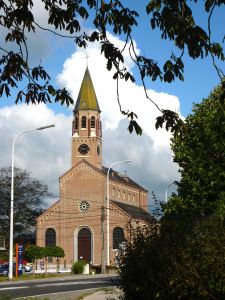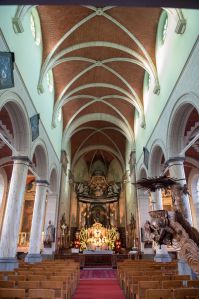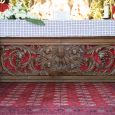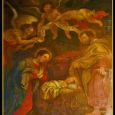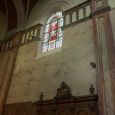Church | 1880 | Neoromanesque | Catholic Church


Map
Opening hours
01 April - 30 September
Mon 10.00 - 16.00
Tue 10.00 - 16.00
Wed 10.00 - 16.00
Thu 10.00 - 16.00
Fri 10.00 - 16.00
Sat 10.00 - 16.00
Sun 10.00 - 16.00
01 December - 07 January
Mon 10.00 - 16.00
Tue 10.00 - 16.00
Wed 10.00 - 16.00
Thu 10.00 - 16.00
Fri 10.00 - 16.00
Sat 10.00 - 16.00
Sun 10.00 - 16.00
Religious offices
Description
Sint-Martens-Leerne is situated on the crossing of two important historical axes: the road from Nazareth to Nevele and the road from Ghent to Deinze. The town center of Sint-Martens-Leerne is situated near that of Sint-Maria-Leerne. The churches of both these villages are only 600 meters apart.
The original medieval church was broken down and replaced in 1845 by the current building. The building nevertheless was severely damaged and had to be restored after World War I. The church was built in neo-romanesque style and consists of three naves.
Within the church, one can find beautiful glass windows: in the ship of the church they are rather modern, in the choir they are nineteenth century glass windows. The pulpit is a remarkable piece of gorgeous handmade woodcarving: a globe carried by angels and guarded by the allegories of the evangelists: the bull and the eagle. The side altar of Our Lady consists of the painting “The birth of Jesus”, a copy of P.P. Rubens while at the side altar there is a painting of Saint Martin that is a copy of Anthony Van Dyck. The main altar is a sarcophagus altar in marble wood. The partially gilded turntable shows the road to Emmaus, flanked by the symbols of Faith and Hope.
uring the Christmas period a romantic crib is built in front of the main altar, which is truly one of a kind.
Sint-Martens-Leerne was nearly 150 years governed by the members of the Crombrugghe family, for the exception of twelve years. The latest mayor was Carl of Crombrugghe. A tag at the church of Sint-Martens-Leerne reminds us of this family.
KIKIRPA : Photo-library online
Photos
Remarkable elements
Copy of a Van Dijck painting
In the church is a copy of a painting by Van Dijck depicting Saint Martin sharing his coat with a poor man.
Main altar
The high altar is in the form of a sarcophagus. He wears a beautiful tabernacle-drum. The altar itself represents the Ascension of Christ.
Copy of the painting by Pieter Paul Rubens
The copy of the painting by Pieter Paul Rubens represents the birth of Jesus and hangs above the altar of Mary.
Pulpit
The church has a beautiful pulpit. The cockpit bowl has the shape of a globe and shows the symbols of the evangelists Matthew and John with banderole. On the back are trophies from the Old and New Testaments (tables of the law, host bearing chalice, cross) in the clouds, flanked by two angels with trumpets. The staircase is decorated with angel heads in the clouds and at the bottom with the symbols of the evangelists Mark and Luke. The door represents the Eye of God while on the soundboard you find a polychromed dove representing the Holy Spirit.
Translated with www.DeepL.com/Translator
Altar rail
As in so many churches, the doors of the original communion bench were transformed into an altar. You can recognize a host carrying chalice in a wreath of clouds surrounded by angel heads, haired by bunches of grapes and acanthus leaves. The parts of the communion bench that are still in their original place contain beautiful sculpted medallions depicting the lamp of God and a pelican puncturing his own breast to feed his young with blood.
Translated with www.DeepL.com/Translator
Marbled walls
The walls of the choir seem to consist of stone marble slabs but when you look closer it turns out to be qualitative paintings, a result of the craftsmanship of the Bishop family, a family of painters from the village.


